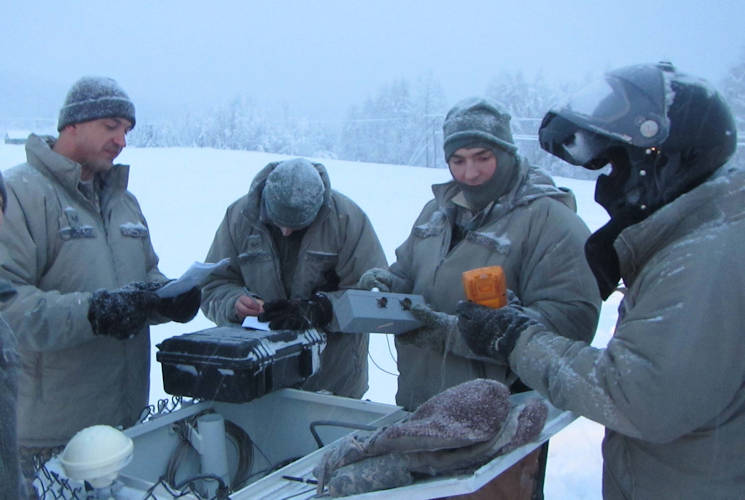|
In 1966, Susan A. Romano, AFTAC Geoffrey Blainey coined the phrase
... tyranny of
distance ... metaphorically referring to how distance and isolation
shaped the history of one of earth’s most intriguing continents,
Australia.
Today, members of the Air Force Technical
Applications Center here are subjected to the tyranny of distance,
but thanks to innovative Airmen, modern technology and
state-of-the-art communications platforms, they are able to adapt
and overcome the so-called tyranny to accomplish their nuclear
treaty monitoring mission.
AFTAC’s Technical Support Squadron, commanded by Lt. Col. Dennis
Uyechi, leads the way by providing a broad range of world-class
operations support to the center’s various mission areas. His
squadron of 145 active duty Airmen and 11 civilians operates and
maintains the U.S. Atomic Energy Detections System, or USAEDS, to
monitor foreign compliance with various international treaties
limiting nuclear testing. His team of highly-skilled experts assists
with detecting special events in the atmosphere, underwater,
underground and in space to determine if the event is nuclear in
nature.
|

December 18, 2015 - Airmen stationed at Detachment 421, Alice
Springs, Australia, conduct maintenance at one of their seismic
arrays in support of the Air Force Technical Applications Center’s
nuclear treaty monitoring mission.(U.S. Air Force photo by Susan A. Romano, AFTAC)
|
The majority of TSUS detachments and operating locations
are positioned overseas, with a handful scattered throughout
the continental United States. Each location serves a
specific purpose ranging in scope from airborne collection
and satellite operations to special equipment maintenance
and logistics support.
“TSUS supports six different
AFTAC mission sets at our nine detachments and four
operating locations,” said Uyechi. “That support is a mixture of
operations and maintenance to AFTAC’s global network of
sensors, the largest in the U.S. Air Force. If a suspected
nuclear explosion occurs somewhere around the world, our
Airmen get to work determining if the event has nuclear
characteristics. Once further analysis is conducted, the
information is reported to U.S. decision-makers at the
highest levels of our government.”
To help them
accomplish that mission, the squadron maintains a variety of
partnerships ranging from support agreements with other
Department of Defense components to international agreements
with host nations, to leases and agreements with local
civilian land owners.
“TSUS Airmen not only must be
excellent technicians in their primary job; they are also
ambassadors of AFTAC and are expected to positively
represent the command and our mission around the world,”
said Uyechi. “Specific activities the Airmen are involved in
include maintaining and repairing special instruments,
performing station upkeep like ground clearing and road
access maintenance, and evaluating scientific data for both
quality and content.”
Uyechi, a 1997 U.S. Air Force
Academy graduate with a degree in Electrical Engineering,
took command of TSUS in October 2015, the first officer to
do so when the squadron was activated after AFTAC
reorganized as a wing equivalent. He has visited all of his
geographically separated detachments across the globe, and
is particularly proud of how his squadron responded to two
recent North Korean declared nuclear tests.
“The
Airmen within our global network worked around the clock to
provide headquarters with everything it needed to properly
evaluate and analyze the situation as it unfolded,” said
Uyechi. “My maintainers’ herculean efforts keep system data
availability over 99 percent, which ensured the equipment
was operational and ready to detect any event. My satellite
operators jumped into gear, evaluating the situation with
space-borne sensors. The WC-135 special equipment operators
and technicians immediately began preparing flight plans and
finalizing logistics to perform their airborne collection
mission. All of these elements were synchronized in an
impressively complex process, with their sole focus on
getting data from the field back to AFTAC and the center’s
network of national labs for further scientific analysis.”
While Uyechi and his leadership staff face typical
work-related hurdles that any organization deals with on a
daily basis, geographical separation seems to pose the
greatest challenge.
|

January 23, 2015 - Airmen stationed at Detachment 460, Eielson
AFB, Alaska, conduct maintenance at one of their seismic arrays in
support of the Air Force Technical Applications Center’s nuclear
treaty monitoring mission. (U.S. Air Force courtesy photo)
|
“We operate in nine different
time zones and have to diplomatically consider various
cultural nuances with our international partners,” he said.
“Those factors sometimes make it difficult to complete the
simplest tasks such as conducting a staff meeting or
responding to a last-minute request for information from
higher headquarters. Email is great for one-way
communication and distributing general information, but it’s
not the best facilitator of real-time, multi-party
conversations about emerging events. But, my Airmen in my
squadron never fail to generate smart and innovative ways to
overcome these challenges.”
Beyond the distance,
geographical challenges, maintenance issues and cultural
differences, Uyechi boasted about one common denominator
that brings his squadron together: the Airmen.
“These
scientific applications specialists, better known as 9S100s,
are enlisted Airmen who are enormously intelligent and
highly skilled,” he said. “They can diagnose complex
problems and improvise workable solutions, which is
critically valuable in situations where access to sites and
equipment may be either limited or prohibitively expensive.
It is a great privilege for me to be a part of AFTAC’s
unique mission, and I am constantly impressed with the
quality of my Airmen and their unwavering dedication to
getting the mission done.”
“Our Airmen are the heart
and soul of this mission,” said Col. Steven M. Gorski, AFTAC
commander. “In addition to the great work they perform for
the center, they are veritable ambassadors for the Air Force
and represent our government as a whole by virtue of the
work they perform in various countries around the world,
sometimes under austere conditions. Their professionalism
and technical knowledge are absolutely second to none.”
By U.S. Air Force Susan A. Romano, AFTAC
Provided
through DVIDS
Copyright 2017
Comment on this article |



